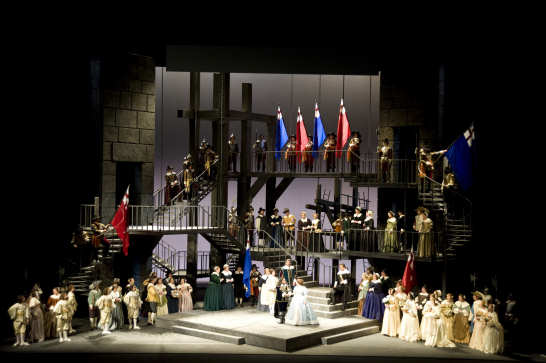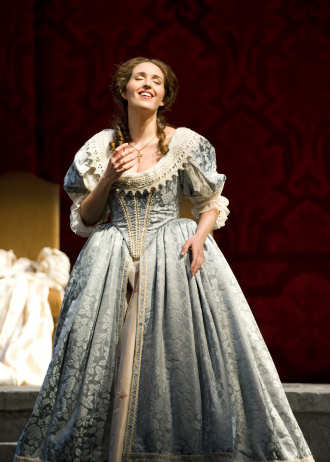Other Links
Editorial Board
- Editor - Bill Kenny
- London Editor-Melanie Eskenazi
- Founder - Len Mullenger
Google Site Search
SEEN AND HEARD INTERNATIONAL OPERA REVIEW
Bellini, I Puritani:
Seattle Opera, soloists, cond. Edoardo Müller,
dir. Linda Brovsky, set designer Robert A. Dahlstrom, costume
designer Peter J. Hall, lighting designer Thomas C. Hase, Marion
Oliver McCaw Hall, Seattle, 17.5.2008 (BJ)

A
spectacular weekend of music theater began for me with this stunning
production of my favorite Bellini opera. Speight Jenkins waited
until his 25th season as Seattle Opera’s general director before
finding a cast that could meet the vocal demands of I Puritani,
and the result was clearly worth waiting for, taking its place among
the perhaps half-dozen practically flawless evenings I have
experienced in the opera house over the past fifty years.
Norah Amsellem
(Elvira) Photo © 2008 Rozarii Lynch
And when Robert A. Dahlstrom’s set was duly seen, what an impact it
made! An intricate structure, darkly metallic in appearance, on
three main levels, it was intersected by a variety of staircases,
some wide and some narrow, some straight and some spiral. The effect
was a triumph in two principal regards: vividly evoking the
atmosphere of Piranesi’s “imaginary prisons,” the set unobtrusively
made the point that Cromwell’s Roundheads constituted a repressive
and confined society; and while it swarmed with principals and with
more than fifty chorus members, it enabled the audience to spot at
once every character making an entry on one of the upper levels.
Thus in each case we were led to wonder what the new entrant would
do, in contrast to the many occasions when, on a single-level stage,
we hear the voice of a new character and have to search around to
find out where it is coming from. Thomas C. Hase’s subtle lighting
reinforced the sense of severity, while yet allowing everything that
mattered to be clearly seen, and Peter J. Hall’s costumes,
originally designed back in 1976 for the Metropolitan Opera, rang
colorful changes on 17th- and 19th-century fashions to match both
the English Civil-War period and the music’s romantic style.
It was not only the singing that thrilled, delighted, and satisfied.
On a previous occasion I was mildly critical of Edoardo Müller’s
conducting, but this time his leadership was impeccable, and the
orchestra played with superb elan and unfailing artistry. Jenkins’s
essay in the program observed that “One does not go to Bellini for
orchestration or indeed for involved orchestral composition,” which
is certainly true of all the composer’s ten earlier operas, but in
Puritani a new awakening of instrumental imagination is
evident. All the orchestral sections did full justice to the
potential of their parts, Mark Robbins’s sumptuous horn obbligato
proving especially memorable in the great second-act duet for
Giorgio and Riccardo, to which Geoffrey Bergler’s rousing trumpet
added visceral excitement. The well-focused work of Beth Kirchhoff’s
chorus was equally impressive.
As to Linda Brovsky’s direction, what happened on stage during the
overture was already a pleasure to observe. Nothing happened
on stage, for Ms Brovsky was content to let the overture play before
a black background, unlike those many contemporary directors who
have to show us how much cleverer and more creative they are than
mere composers and librettists, by arranging all sorts of more or
less irrelevant stage business at the point where we should be
allowed the luxury of pleasurably waiting for the curtain to rise.

Bellini being concerned above all with emotion and its expression
through the human voice, all of these elements were ancillary to the
main business of the evening–the performances of the four principals
and their fellow singers. Thanks to their own talents and no doubt
also to Linda Brovsky’s firm directorial hand, I never found myself
thinking about any of the performers’ acting. There was none of the
usual consciousness that one or other principal was more convincing
than his colleagues: everyone simply was the person he was on
stage to portray.
Nor, I am happy to report, was there a single weak link in terms of
voice quality, technique, or stylistic command in the only one of
the two casts that I had the opportunity to see and hear. In the
role of Elvira’s uncle Giorgio, John Relyea’s majestic
bass-baritone, formidable in sheer size and lustrous in timbre, was
paired ideally with the more incisive baritone of Mariusz Kwiecien
as Riccardo. As Arturo, Lawrence Brownlee, a most impressive product
of Seattle Opera’s Young Artists program, delivered tenor singing of
thrilling impact; he was lyrical and heroic in the same breath,
fearless in tackling Bellini’s often stratospheric tessitura, and
notably accomplished in his Italian diction. But perhaps, aside from
enthusiastic praise for Simeon Esper’s Bruno Robertson, Joseph
Rawley’s Gualtiero Walton, and Fenlon Lamb’s Enrichetta, the Elvira
should be accorded the last word. Alike when she was being sane and
when she was being deranged, French soprano Norah Amsellem sang with
awe-inspiring virtuosity and touching truth of emotion. Her voice is
as lovely as her looks, and she acts well too. As their
contributions to this wonderful production brilliantly demonstrated,
she and Brownlee are two young singers with already high
achievements and golden futures.
Back
to Top
Cumulative Index Page
